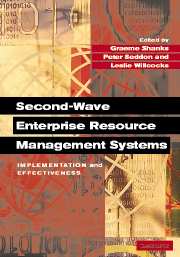Book contents
- Frontmatter
- Contents
- List of Contributors
- Introduction: ERP – The Quiet Revolution?
- Part I Implementation and Effectiveness: Overview
- 1 Learning from Adopters' Experiences with ERP: Problems Encountered and Success Achieved
- 2 Innovating with Packaged Business Software: Towards an Assessment
- 3 A Comprehensive Framework for Assessing and Managing the Benefits of Enterprise Systems: The Business Manager's Perspective
- 4 The Continuing ERP Revolution: Sustainable Lessons, New Modes of Delivery
- Part II From Risks to Critical Success Factors
- Part III From Learning to Knowledge
- Part IV Cultural Aspects of Enterprise Systems
- Part V Future Directions
- Index
- References
2 - Innovating with Packaged Business Software: Towards an Assessment
from Part I - Implementation and Effectiveness: Overview
Published online by Cambridge University Press: 05 February 2012
- Frontmatter
- Contents
- List of Contributors
- Introduction: ERP – The Quiet Revolution?
- Part I Implementation and Effectiveness: Overview
- 1 Learning from Adopters' Experiences with ERP: Problems Encountered and Success Achieved
- 2 Innovating with Packaged Business Software: Towards an Assessment
- 3 A Comprehensive Framework for Assessing and Managing the Benefits of Enterprise Systems: The Business Manager's Perspective
- 4 The Continuing ERP Revolution: Sustainable Lessons, New Modes of Delivery
- Part II From Risks to Critical Success Factors
- Part III From Learning to Knowledge
- Part IV Cultural Aspects of Enterprise Systems
- Part V Future Directions
- Index
- References
Summary
Introduction
In the 1990s many firms turned to software packages when they replaced the older, often home-built systems in their application portfolios. They chose to buy, rather than build, their new systems. Broadly, they followed the prevailing wisdom to downsize themselves so as to focus on their ‘core competencies’ and to outsource other tasks to the market. Many found no compelling logic for continued in-house development of their application software. Some, with their staffs already reorganized and reduced through reengineering, were simply no longer in a position to undertake major development tasks.
Replacement of systems had in the 1990s become a priority for many firms. These organizations felt increasingly burdened by their ‘legacy systems’. Their support staff were often committed to a maintenance task for which the costs were all too apparent and the benefits appeared to be marginal and remedial. Their home-built software also often resided on expensive mainframes widely viewed as heading rapidly toward obsolescence. Further, users found this software increasingly cumbersome to work with in comparison to their newer PC-based tools with their graphical user interfaces.
It was in this context that the 1990s gave rise to ERP (enterprise resource planning), a significant innovation in the packaged software market. The vision for ERP was first articulated by the Gartner Group (Wylie, 1990). It took an ‘enterprise-wide view’ of traditional application software, allowing for internal integration of the technical and business core, as well as external integration with business customers.
- Type
- Chapter
- Information
- Second-Wave Enterprise Resource Planning SystemsImplementing for Effectiveness, pp. 56 - 73Publisher: Cambridge University PressPrint publication year: 2003
References
- 2
- Cited by



